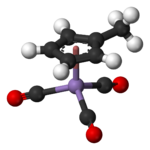This article may be unbalanced toward certain viewpoints. (October 2020) |

| |

| |
| Names | |
|---|---|
| IUPAC name
tricarbonyl(methyl-η5-
| |
| Other names
MMT, CI-2, Combustion Improver-2, Manganese tricarbonylmethylcyclopentadienyl, 2-Methylcyclopentadienyl manganese tricarbonyl
| |
| Identifiers | |
3D model (JSmol)
|
|
| ChemSpider | |
| ECHA InfoCard | 100.031.957 |
| EC Number |
|
PubChem CID
|
|
| RTECS number |
|
| UNII | |
| UN number | 3281 |
CompTox Dashboard (EPA)
|
|
| |
| |
| Properties | |
| C9H7MnO3 | |
| Molar mass | 218.09 g/mol |
| Appearance | pale yellow to dark orange liquid[1] |
| Odor | faint, pleasant[1] |
| Density | 1.38 g/cm3 |
| Melting point | −1 °C (30 °F; 272 K) |
| Boiling point | 232 to 233 °C (450 to 451 °F; 505 to 506 K) |
| low[vague] | |
| Solubility | Hydrocarbons (petrol), ether, alcohol, THF |
| Vapor pressure | 7 mmHg (100°C)[1] |
| Structure | |
| Tetrahedral at Mn | |
| Hazards | |
| Occupational safety and health (OHS/OSH): | |
Main hazards
|
Flammable, toxic |
| GHS labelling: | |
 
| |
| Danger | |
| H301, H310, H315, H330, H372, H410 | |
| P260, P273, P280, P284, P301+P310, P302+P350 | |
| Flash point | 110 °C; 230 °F; 383 K[1] |
| NIOSH (US health exposure limits): | |
PEL (Permissible)
|
C 5 mg/m3[1] |
REL (Recommended)
|
TWA 0.2 mg/m3 [skin][1] |
IDLH (Immediate danger)
|
N.D.[1] |
| Related compounds | |
Related compounds
|
ferrocene Mn2(CO)10 dicyclopentadiene |
Except where otherwise noted, data are given for materials in their standard state (at 25 °C [77 °F], 100 kPa).
| |
Methylcyclopentadienyl manganese tricarbonyl (MMT or MCMT) is an organomanganese compound with the formula (C5H4CH3)Mn(CO)3. Initially marketed as a supplement for use in leaded gasoline, MMT was later used in unleaded gasoline to increase the octane rating. Following the implementation of the Clean Air Act (United States) (CAA) in 1970, MMT continued to be used alongside tetraethyl lead (TEL) in the US as leaded gasoline was phased out (prior to TEL finally being banned from US gasoline in 1995), and was also used in unleaded gasoline until 1977. Ethyl Corporation obtained a waiver from the U.S. EPA (Environmental Protection Agency) in 1995, which allows the use of MMT in US unleaded gasoline (not including reformulated gasoline) at a treat rate equivalent to 8.3 mg Mn/L (manganese per liter).[2]
MMT has been used in Canadian gasoline since 1976 (and in numerous other countries for many years) at a concentration up to 8.3 mg Mn/L (though the importation and interprovincial trade of gasoline containing MMT was restricted briefly during the period 1997–1998)[3][4] and was introduced into Australia in 2000. It has been sold under the tradenames HiTEC 3000, Cestoburn and Ecotane.[5][6] MMT is also used in China.[7]
- ^ a b c d e f g NIOSH Pocket Guide to Chemical Hazards. "#0409". National Institute for Occupational Safety and Health (NIOSH).
- ^ "60 FR 36414 - Fuels and Fuel Additives; Grant of Waiver Application".
- ^ "Threat of NAFTA Case Kills Canada's MMT Ban: Challenge over gasoline additive could have cost Ottawa millions". The Globe and Mail. July 20, 1998.
- ^ "MMT, A Risk Management Masquerade" (PDF).
- ^ Frumkin, Howard; et al. (1997). "Manganese in the US Gas Supply". American Journal of Industrial Medicine. 31 (1): 107–115. doi:10.1002/(SICI)1097-0274(199701)31:1<107::AID-AJIM16>3.0.CO;2-6. PMID 8986262.
- ^ Patterson, Steve (15 September 2009). "Report: Owners of Jacksonville's T2 Lab never knew risks of deadly explosion". The Florida Times-Union. Archived from the original on 1 December 2022. Retrieved 1 December 2022.
- ^ Geng, Peng; Zhang, Hui (2015). "Combustion and emission characteristics of a direct-injection gasoline engine using the MMT fuel additive gasoline". Fuel. 144: 380–387. doi:10.1016/j.fuel.2014.12.064.